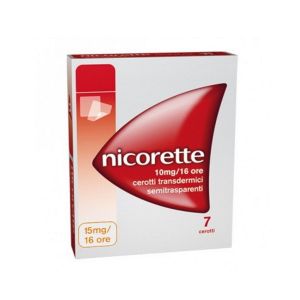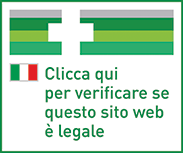Ship in Europe, Find out rates!
Nicorette 15mg/16H Semitransparent Transdermal Patches Nicotine

- box Delivery in Italy in 24/48 and free returns
- star3.000+ positive reviews
- dropboxOver 60,000 products in the catalog
Nicorette 15 mg / 16 hours 7 patches is indicated in the treatment of nicotine dependence and promotes smoking cessation in motivated smokers to quit.
Nicorette Transdermal Patches, here in the 15mg pack, is indicated in the treatment of nicotine addiction and promotes smoking cessation in motivated smokers to quit.
Dosage
While administering Nicorette Transdermal Patches the patient should completely stop smoking. Advice and support usually increase the chances of success. Begin therapy with the 15mg / 16 hour patch using one patch per day for 8 weeks. After 8 weeks, the treatment should be gradually reduced by using a 10 mg / 16 hour patch daily for another 2/3 weeks and continuing for another 2/3 weeks with a 5 mg / 16 hours daily patch. Treatment should last no more than 3 months. The duration of treatment, however, may vary depending on the individual response. It is not recommended to use the patch beyond 6 months of therapy. Only some former smokers may need prolonged treatment to avoid resuming smoking. The patch should be applied to an intact surface of the skin as soon as you wake up in the morning and removed in the evening before going to sleep. How to apply the Nicorette Transdermal Patches should be applied to a clean, dry, intact and hairless skin surface, for example on the hip, upper arm or chest. Apply the patch on the chosen skin area, avoiding touching the adhesive part with the fingers and pressing with the palm of the hand for 10-20 seconds It is necessary to change the skin surface on which to apply the patch daily and avoid applying it consecutively on the same area . Nicorette Transdermal Patches should not be given to people under 18 years of age unless under medical supervision. There is still insufficient experience of using Nicorette Transdermal Patches in this age group. Do not exceed the recommended dose.
Active principles
Nicorette transdermal patches are available in the formulations of 5 mg / 16 hours (surface of 10 cm²), 10 mg / 16 hours (surface of 20 cm²), 15 mg / 16 hours (surface of 30 cm²) and contains 0.83 mg of nicotine / cm². Nicorette Semi-transparent Transdermal Patches are available in the formulations of 10 mg / 16 hours (surface of 9 cm²), 15 mg / 16 hours (surface of 13.5 cm²) and contains 1.75 mg of nicotine / cm². For the full list of excipients see section 6.1.
Excipients
Nicorette transdermal patches: non-woven polyester, siliconized polyester, low molecular weight polyisobutylene, medium molecular weight polyisobutylene, polybutene. Nicorette semi-transparent transdermal patches: Nicotine matrix: medium chain triglycerides, basic butylated methacrylate copolymer, polyethylene terephthalate film (PET). Acrylic matrix: acrylic adhesive solution, potassium hydroxide, croscarmellose sodium, aluminum acetylacetonate, polyethylene terephthalate film (PET), aluminized on one side and siliconized on both sides.
Contraindications
Non-smokers or occasional smokers. The drug is contraindicated in pregnancy and lactation. Since the weaning effect of NICORETTE Transdermal Patches is expressed thanks to the absorption of nicotine into the blood, NICORETTE Transdermal Patches is contraindicated in patients in whom tobacco smoking has been prohibited by the doctor and in particular in: pediatric subjects; people who have had heart attacks or brain accidents; subjects who have suffered or suffer from circulation defects of any kind; subjects suffering from palpitations, cardiac arrhythmias, heart disease, arterial hypertension, hyperthyroidism, diabetes and pheochromocytoma; people with skin disorders that can complicate patch therapy; known hypersensitivity to nicotine.
Warnings
Discontinue treatment in case of severe or persistent skin reactions. Do not smoke and do not take other medicinal products containing nicotine; the extra nicotine can be harmful. Nicotine is a highly toxic substance: doses of nicotine tolerated by adults can cause severe symptoms of poisoning in children and can be fatal. (see paragraph 4.9) Periodic medical check-ups are recommended, in order to check the progress in quitting smoking. The risk of nicotine administration in replacement therapy must be weighed against the risk of not quitting smoking. Nicorette Transdermal Patches should be used under medical supervision in patients with cardiovascular disease or who have had a serious cardiovascular problem or hospitalization for cardiovascular problems within 4 weeks prior to starting treatment (e.g. stroke, myocardial infarction, unstable angina pectoris , cardiac arrhythmia, coronary artery bypass grafting and angioplasty) or in those with uncontrolled hypertension. Careful use of Nicorette Transdermal Patches is suggested in patients with severe or moderate hepatic insufficiency, severe renal insufficiency, acute gastric or duodenal ulcers. Nicotine, whether produced by substitution therapy or produced by smoking, causes the release of catecholamines from the adrenal medulla. Therefore, Nicorette Transdermal Patches should also be used with caution in patients with hyperthyroidism or pheochromocytoma. A lower dose of insulin may be required in patients with diabetes mellitus as a result of stopping smoking.
Pregnancy
Smoking during pregnancy is associated with serious health risks for the woman, the fetus and the baby. Smoking can cause fetal harm such as intrauterine growth retardation, premature birth or neonatal death. It is therefore desirable to stop as soon as possible. The risk of nicotine administration in replacement therapy must be weighed against the risk of not quitting smoking. Pregnancy Pregnant or breastfeeding women should only use Nicorette transdermal patches under medical supervision. Nicotine reaches the fetus and affects its cardiorespiratory system. The effect is dose-dependent. The risks to the fetus from using Nicorette transdermal patches are not known. Breastfeeding Nicotine passes freely into breast milk in quantities that can have harmful effects on the infant even at therapeutic doses.
Side effects
Nicorette transdermal patches can cause dose-dependent adverse reactions similar to those resulting from the use of nicotine administered by any other means. About 20% of users of Nicorette transdermal patches experienced mild skin reactions during the first week of treatment. Some symptoms, such as dizziness, headache, and insomnia, may be related to the withdrawal symptoms associated with quitting smoking. An increased incidence of aphthous ulcer may occur following smoking cessation. The cause is not clear. Very common (> 1/10); common (> 1/100, <1/10); uncommon (> 1/1000, <1/100); rare (> 1/10000, <1/1000); very rare (<1/10000), including isolated cases.
Nervous system disorders
Common Vertigo, headache and insomnia
Heart ailments
Uncommon Palpitations
Very rare Reversible atrial fibrillation
Gastrointestinal disorders
Common Gastrointestinal disturbances, nausea, vomiting
Skin and subcutaneous manifestations
Uncommon Urticaria
General disorders and administration site conditions
Very common Itching
Common Erythema
Overdose
Overdose can be caused by the use of several patches at the same time, if the patient has very mild nicotine addiction or if, concomitantly, he uses other sources of nicotine including smoking. Excessive use of nicotine, either by therapeutic administration or by smoking, can cause symptoms of overdose. Symptoms of overdose are typical of acute nicotine poisoning and include nausea, salivation, diarrhea, abdominal pain, sweating, headache, dizziness, hearing disorders and marked weakness. At high doses, the symptoms described may be accompanied by hypotension, weak and irregular pulse, difficulty in breathing, prostration, circulatory collapse and convulsions. Warning: Doses of nicotine that are tolerated by adult smokers can cause severe poisoning symptoms in young children and can be fatal. Treatment of overdose: Nicotine intake should be stopped immediately and the patient treated symptomatically. Activated charcoal reduces the gastrointestinal absorption of nicotine. The acute minimal lethal oral dose of nicotine in humans is thought to be between 40 mg and 60 mg.
Interactions
Smoking (but not nicotine) is associated with an increase in CYP1A2 enzyme activity. After smoking cessation, a reduction in the clearance of substrates of this enzyme may occur.This may lead to an increase in plasma levels of some medicinal products which may have potential clinical importance for those drugs with a narrow therapeutic index, such as phenacetine, caffeine, theophylline, tacrine, and clozapine and ropinirole. Smoking cessation may also increase the concentration of other drugs partially metabolised by the CYP1A2 enzyme, such as imipramine, pentazocine, olanzapine, clomipramine and fluvoxamine, although data are scarce and possible clinical significance unknown. Furthermore, stopping smoking may decrease the absorption of glutethymide and the phase I metabolism of propoxyphene. Both smoking and nicotine can increase circulating levels of cortisol and catecholamines. Therapies with agonists or adrenergic blockers may need to be fine-tuned in relation to the stages of nicotine therapy or the amount of cigarettes smoked. Therefore in case of concomitant therapies it is necessary to consult the doctor. Limited data also indicate that smoking can induce the metabolism of flecainide and pentazocine.
storage
Store at a temperature not exceeding 30 ° C


